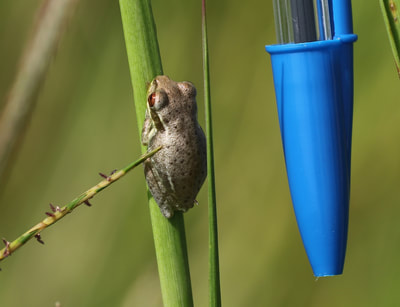 Antillean Dragonlet Erythrodiplax justiniana 29 Sept 2017 Albaiza, Camagüey © Tim Norriss
Antillean Dragonlet Erythrodiplax justiniana 29 Sept 2017 Albaiza, Camagüey © Tim Norriss |
Our destination this morning was to the grasslands at Albaiza just a few miles outside Camagüey. It was just Doug and I today and although this is Doug's local patch, I have only been here once before last year and then it had been rather dry. This time the ground was quite wet due to the recent rain so I was interested to see the difference. We soon saw a few skippers and Smudged Yellow Eurema lucina and Little Yellow Pyrisitia lisa but this site is also home of the rarer Cuban Yellow Eurema amelia and Doug soon called that he had found one. Both Mexican Fritillary Euptoieta hegesia and Variegated Fritillary Euptoieta claudia followed. One of the main differences this time was that there were quite a few Odonata. The origin of these seemed to be from a small pond nearby. The Familiar Bluet Enallagma civile is widespread in N&C America and the West Indies but it was the first time we had seen it. Males of the Band-winged Dragonlet Erythrodiplax umbrata were appearing in greater numbers as each day went past But it was a very small dragonfly buzzing about catching small insects in some long grass that caught my eye. It was by far the smallest dragonfly I had ever seen being only about 30mm long. It appeared all dark in flight but when we saw it eventually settle it actually had quite a lot of blue on the abdomen. It is an immature male Antillean Dragonlet Erythrodiplax justiniana.  Antillean Dragonlet Erythrodiplax justiniana 29 Sept 2017 Albaiza, Camagüey © Tim Norriss Antillean Dragonlet Erythrodiplax justiniana 29 Sept 2017 Albaiza, Camagüey © Tim Norriss In the long grass were several Common Buckeye Junonia coenia which looked as if they had been roosting here. Closer inspection showed they were taking moisture in the form of dew from the grass heads. And then Doug managed to find a full grown larva on the foodplant Tabebuia trachycarpa. Whilst busy photographing the adult Junonia in the long grass I had noticed what I took to be an insect jump from one grass stem to another but in fact was a small Cuban Treefrog Osteopilus septentrionalis. We had seen a couple a few days previously at Gibara but the pictures weren't great so it was good to get another chance. This one was only 22mm long but they get much bigger than this. Doug had mentioned to me previously that he had seen a different anole here on previous occasions and it didn't take him long to find one. They apparently like the dwarf palms that grow here. I don't yet know what it is so I will send a picture to Luis Manuel in Habana. It might prove to be just a very well-marked form of Cuban Brown Anole Anolis sagrei which is a very variable species but I've never seen one like this before. The commonest reptile here was Cuban Whiptail Pholidoscelis auberi and again they didn't look much like others we have seen elsewhere as these had three bright yellow dorsal stripes. And a Cuban Broken-dash Wallengrenia misera is something we haven't often seen. By lunch we had to make our way back into town, say farewell to Doug and his family and set off back to our hotel near Guardalavaca but not before stopping for a wonderful lunch that Doug's wife Noris had prepared, and some time in the garden to photograph the larvae of Canna Skipper Calpodes ethlius.
0 Comments
Leave a Reply. |
Welcome to our Blog
Here we will post interesting news about what we and others have seen in Cuba. Archives
July 2024
Categories |
























 RSS Feed
RSS Feed